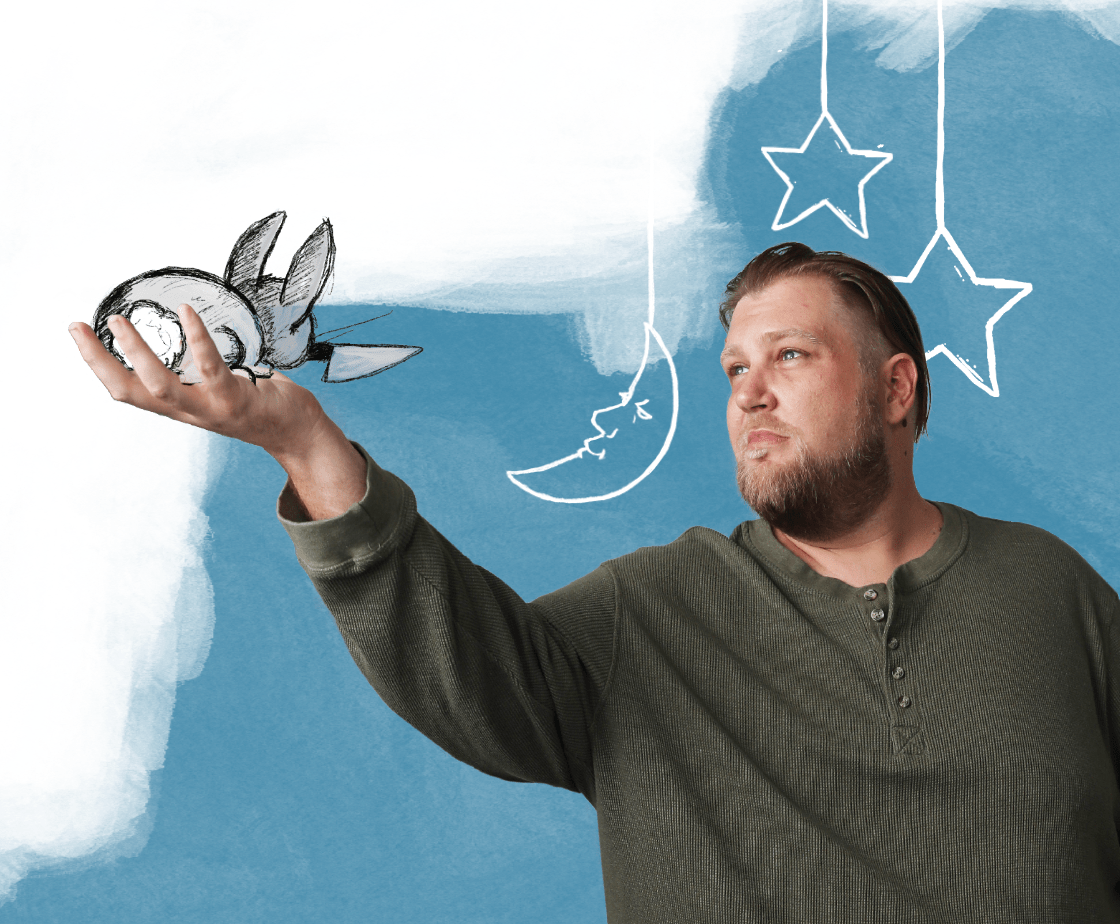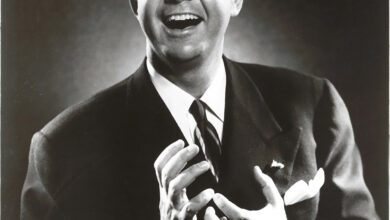
By Melissa Deskovic
It’s a stormy afternoon. Rain clouds have unleashed a fury of water over the city, and although it’s only 4 pm, if one didn’t know any better, they would think it was midnight with how dark the sky had become. Other than the sounds of rain, everything is productively silent. The workday is winding down as we wait for Chad Taylor to arrive. A local celebrity of sorts those in the artistic community know him well. He is recognized not only by his name—but for his work. He is the definition of a true creative. He has struggled for his art, and through blood, sweat and tears, he founded and kept the Insomniac Theatre alive. As he opens the door, the entire office lights up, and suddenly the stormy weather outside is of no consequence. Everyone loves him, and he is greeted with open arms.
Born in Ft. Lauderdale and raised in Ocala, Taylor has always had a love for the arts “I was always one of those ‘overdramatic’ kids,” he states. “When I was 11, I signed up for the Arts for All summer program at the Civic Theatre. My first role was as the Major General in the Pirates of Penzance, and as soon as the spotlight hit me, I was hooked.”
His ability to weave a story is magnetic. A trait honed over decades in the theatre; one cannot help but become enveloped in his vividly detailed anecdotes. He shares personal musings from a life devoted to his passion for storytelling; and for his knife-wielding rabbit named Slippers Aloysius Von Bunnybutt of the Honeycut Von Bunnybutts. “People think I joke about that,” he laughs. “But I was twenty minutes late to a meeting one time because the bunny had me trapped.” Speaking with a twinge of nonchalance, he sets the scene, and his delivery is perfect. “I used to live downtown right off the square, and I used to let my bunny run around the room. You would hear the clack clack clack on the wood floors. I was laying in my bed writing—I was working on Barfly on the Wall—and it was about time for me to go to a meeting, and here’s the edge of the bed.” He raises his arm. A prop in this imaginative tale “…and the bunny’s head goes like this.” He raises his other hand imitating a bunny menacingly looking over the bed. “…and it’s got a knife in its mouth, and I don’t know where the hell it got it.” He laughed, “Then it does this.” He lowers his hand to mimic bunny disappearing beside the bed. “I was scared to move because I’ve seen Pet Sematary. I know what happens if I move.” The office roars with laughter. He has our full attention.
This story, although inconceivable for most, is just a glimpse at the type of situations he finds himself in. His journey is somewhat a comedy of errors. And one that he is happy to discuss.
“Have you seen my car wash video on Facebook?” He asks, smiling. Again the office erupts with laughter as the video plays. The footage he captured plays out as if written for the big screen. In the video, you hear him exclaim in delighted horror as he helplessly watches the brightly colored soap start pouring in through a leak on the driver’s side door. All he can do is laugh. Because it’s the picture-perfect end to a day that was a laundry list of mishaps and this is just another day in the life for Taylor.
His love for storytelling is nothing new. His journey has taken him from Ocala to Orlando and eventually out to Los Angeles. “I always thought the best way for me to learn something was to do it, so I wanted to be where there were more opportunities for me to learn. So one day I just said ‘I think I’ve gone as far as I can in Florida, I want to move to L.A.’ I sold everything I own, and about a week later there I was.”
As he recounts his days out West, you can hear the fondness he has for the journey. Aside from New York, the Los Angeles entertainment scene is a rough one. It’s home to some of the greatest acts you will never know because the competition is fierce. Politically charged, it’s often more about who kisses the ring than who is the most talented. “I got a lot of callbacks, but always lost the roles to the same two more well-known guys, so I decided to scratch the theatre itch again. That’s when I started producing my own shows, and it felt like home.”
The official start of Insomniac Theatre Company was created not out of a long-held desire to establish a formal business, but as a matter of convenience. “One of the venues I wanted to rent—if I didn’t want to have to pay extra insurance—I would have to have an actual company. I decided to call it Insomniac Theatre Company because I’ve been an insomniac since I was 13,” he explains. “So that is technically how Insomniac got its start—11 years ago in California, as a joke.”
 Through a tragic twist of fate, the time in Los Angeles was abruptly interrupted. “I ended up moving back to Ocala because they told me that I only had a year to two years left of hearing. I was going deaf.” He states. “I wanted to come back and be around family to adjust. Then, I got bored,” he jokes. Making the most of being back home, he once again re-entered the theatre scene. Despite prior experience, community theatre can be extremely difficult. The dance between the players and the decision-makers is a choreographed movement that can grow tiresome. “Even though I was able to do theatre professionally out in Los Angeles—which is one of the hardest markets—it was very hard for me to get on stage or cast in a show here. So I thought, `If I can’t get cast on stage then who else who has talent and can’t get on stage?’ I figured I would start something to give people another opportunity.”
Through a tragic twist of fate, the time in Los Angeles was abruptly interrupted. “I ended up moving back to Ocala because they told me that I only had a year to two years left of hearing. I was going deaf.” He states. “I wanted to come back and be around family to adjust. Then, I got bored,” he jokes. Making the most of being back home, he once again re-entered the theatre scene. Despite prior experience, community theatre can be extremely difficult. The dance between the players and the decision-makers is a choreographed movement that can grow tiresome. “Even though I was able to do theatre professionally out in Los Angeles—which is one of the hardest markets—it was very hard for me to get on stage or cast in a show here. So I thought, `If I can’t get cast on stage then who else who has talent and can’t get on stage?’ I figured I would start something to give people another opportunity.”
The independent nature of Insomniac Theatre draws quite the mix of creatives. A community with a passion for the performing arts, without the overlaying corporate stigma often rampant in mainstream theatre. Obstacles don’t matter. Industry politics merely feed the desire to succeed. It’s the support from the audience that helps them go on. Bringing Ocala quality, live shows to enjoy, and sparking conversation among the community is at the heart of the Insomniac mission.
But in order for the arts to thrive locally, it needs support. For the Insomniac Theatre, support has been a hard-fought battle. It’s something they have wrestled with tooth and nail, and even when the doors were shut in their face, they persevered. “We were always kind of the island of misfit toys,” he jokes. “Our first big event was Life Imitates Art, where I got artwork and wrote original short plays about each piece. I wanted to give the proceeds from the show (to a charity), and all I asked was that they allow us to say we were giving away the proceeds. I had to go to 33 different non-profits before someone would say they would take money. I’ve been trying to find an organization since then to do it again, but nobody’s been interested.”
In a stroke of much-needed luck, they finally found an ally in Nancy Ledding and the Marion Cultural Alliance (MCA) who opened their doors and gave Insomniac a home. It was with her help they acquired the historic bank building on the downtown square. Built in 1911 this 3,975 square foot building would be their home for more than 150 different productions over the course of three and a half years.
There are benefits to being an independent theatre. There is freedom to push the envelope delving into topics that others may find taboo. “We were a smaller venue, and we were at the place where we really had nothing to lose. Like when we did Hedwig And The Angry Inch,” he says proudly. “No one else would touch that, but it’s such a good show. We had people come back four or five times because they loved it so much.”
The downtown location was a labor of love for all involved, but there is only so far love will go. With a lack of funding, eventually the theatre officially shut its doors. A consistent trend, the performing arts have always battled for community support. For those who pour their souls into this medium, it’s an exhausting experience. One that, over time, chips away at the passion that once kept them going. “I was just done. Just mentally, physically, financially done,” he recalls. “It had gotten to a point where it felt like there was no community support. I would swallow my pride—go ask for help from places—and nothing. I worked a day job and then worked another 60-70 hours a week at the theatre. Eventually, I got so burned-out, if I didn’t close it down I probably would have put myself in the ground.” After all the work poured into the venue, after all the shows were over and the cheers subsided, they turned off the spotlight and called it a day. And after 12 years of working, he finally took a vacation.
Unbeknownst to him, his talent for production had garnered the attention of Matthew Wardell and Pamela Calero-Wardell who at the time were busy trying to put together the puzzle that would become The Reilly Arts Center. “They said ‘If we do this, would you be interested in putting on some shows there?’ I said ‘I don’t know.’” He laughs now as he looks back, but it was their passion for what they were doing with The Reilly that influenced further introspection. The final crescendo arrived in a manner familiar to him: the theatre. A prequel to Peter Pan, Peter and the Starcatcher was not supposed to be on stage that weekend, but the day of his arrival in New York, the production company announced a limited, Off-Broadway run. Sitting in the audience, he found himself overcome with emotion. “It reawakened to me what live theatre should be.”
 The Reilly was very gracious, offering full creative control over his productions. As the resident theatre company of The Reilly, he took a tip-toe-into-the-deep-end approach, gauging audience reaction and interest. “I played it safe the first year, and then we had the idea for the shadowcast series, which we had never done. We wanted to do shadowcasts to a movie that should not have a shadowcast to it. So we did Jaws.”
The Reilly was very gracious, offering full creative control over his productions. As the resident theatre company of The Reilly, he took a tip-toe-into-the-deep-end approach, gauging audience reaction and interest. “I played it safe the first year, and then we had the idea for the shadowcast series, which we had never done. We wanted to do shadowcasts to a movie that should not have a shadowcast to it. So we did Jaws.”
Shadowcasting is especially difficult for both actors and directors. Following a movie move-for-move brings a level of creativity to the stage that keeps time with the screen and is only accomplished through a strict set of rules. “I love shadowcast because it’s essentially my brain on stage.” Surprising audiences with their theatrical choices at every turn filled seats quickly, and audiences clamored for more. So they pushed the envelope once again. “I got to show The Reilly what we could really do with Sweeny Todd. It was the first show we had money behind. People came up to me who had seen the revival on Broadway and said ‘Yours is better.’ The reasoning I think is because ours is more intimate. You feel like you’re a part of the show.”
As we look towards the future, the dream that Chad Taylor built, is solid. With support from the community, the Reilly Center, and a strong team—he is ready to take his final bow. In November Taylor’s run with Insomniac Theatre will come to a close. “I think I’ve taken it as far as I can. If I want it to grow and change, then I need to put someone in there that has a different viewpoint than I do you know. In November he will hand over the reins to Sebestian Lombardo. Familiar with Insomniac Theatre, Lombardo began his work with the theatre company on the stage. He’s been Taylor’s right hand through many of their productions; he has a good grasp of the process, and a great vision for the future. And now that Taylor has weathered the storm he feels secure enough to hand it over to a new generation.
“I’ve always been a believer in that art, at the end of the day, should make you feel something—and that was always our goal,” he reflects. “We may not have done the shows that people have heard of before, but people were always able to come and know that when they came, they could see a good show—and they’d feel something during it.”
The theatre can be a great teacher. Whether you are on stage or in the audience every story has a twist. For Taylor, there was one thing he didn’t expect, one thing about the process that was surprising. When posed with this question he leaned forward, as he looked away in thought.
With a heavy sigh his reply was simple: “How hard it is to let go.” The room fell into a bittersweet silence. He has had a great run but now it’s time to move on to other things and hopefully this time- his bunny will be a little more supportive.






